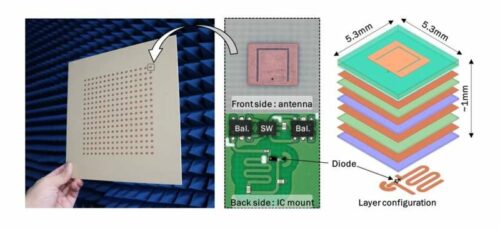The breakthrough in 5G technology with a new transceiver expands network coverage to areas previously blocked by obstacles.

Scientists at Tokyo Tech have developed a new 256-element transceiver array for non-line-of-sight 5G communication, which is wirelessly powered and boasts high efficiency in power transmission and conversion.
The design could significantly expand 5G network coverage to areas with link blockage, thereby enhancing flexibility and the scope of coverage. This advancement may lead to more widespread access to high-speed, low-latency communications.
Millimeter wave 5G communication utilizes extremely high-frequency radio signals (24 to 100 GHz), offering promising advancements in speed, latency, and network capacity for next-generation wireless communications.
Nevertheless, today’s 5G networks encounter significant challenges, including low signal-to-noise ratios (SNR), essential for quality communication, and link blockages that occur when obstacles like buildings interrupt the signal path between transmitter and receiver.
Beamforming, a crucial method for long-range communication using millimeter waves, improves SNR by directing radio signals into a concentrated beam toward a specific direction, similar to a flashlight focusing light on a target. However, this technique is traditionally constrained to line-of-sight communications and can be impaired by obstacles.
Moreover, materials like concrete and modern glass can severely diminish signal strength, highlighting the critical need for a non-line-of-sight (NLoS) relay system to bolster 5G coverage, particularly indoors.
To tackle these challenges, the team have developed a new wirelessly powered relay transceiver for 28 GHz millimeter-wave 5G communication. The proposed transceiver features 256 rectifier arrays equipped for 24 GHz wireless power transfer (WPT). These arrays are composed of discrete integrated circuits (ICs), including gallium arsenide diodes, and baluns that connect balanced and unbalanced (bal–un) signal lines, double-pole double-throw (DPDT) switches, and digital ICs.
Explaining the motivation behind their study, Associate Professor Atsushi Shirane from the Laboratory for Future Interdisciplinary Research of Science and Technology at Tokyo Institute of Technology(Tokyo Tech) says, “Previously, for NLoS communication, two types of 5G relays have been explored: an active type and a wireless-powered type. While the active relay can maintain a good SNR even with few rectifier arrays, it has high power consumption.
Reference: Michihiro Ide et al, A 256-Element Phased-Array Relay Transceiver for 5G Network Using 24-GHz Wireless Power Transfer With Discrete ICs, IEEE Microwave and Wireless Technology Letters (2024). DOI: 10.1109/LMWT.2024.3395300






